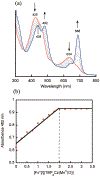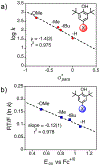Factors Affecting Hydrogen Atom Transfer Reactivity of Metal-Oxo Porphyrinoid Complexes
- PMID: 30403479
- PMCID: PMC6676912
- DOI: 10.1021/acs.accounts.8b00414
Factors Affecting Hydrogen Atom Transfer Reactivity of Metal-Oxo Porphyrinoid Complexes
Abstract
There has been considerable interest in hydrogen atom transfer (HAT) reactions mediated by metal/oxygen species because of their central role in metalloenzyme function as well as synthetic catalysts. This Account focuses on our progress in synthesizing high-valent metal-oxo and metal-hydroxo porphyrinoid complexes and determining their reactivities in a range of HAT processes. For these studies we have utilized corrolazine and corrole ligands, which are a ring-contracted subclass of porphyrinoid compounds designed to stabilize high-valent metal complexes. The high-valent manganese complex MnV(O)(TBP8Cz) (TBP8Cz = octakis(4- tert-butylphenyl)corrolazine3-) provided an early example of a well-characterized low-potential oxidant that can still be effective at abstracting H atoms from certain C-H/O-H bonds. Approximating the thermodynamics of the HAT reactivity of the MnV(O) complex and related species with the help of a square scheme approach, in which HAT can be formally separated into proton (p Ka) and electron transfers ( E°), indicates that affinity for the proton (i.e., the basicity) is a key factor in promoting HAT. Anionic axial ligands have a profound influence on the HAT reactivity of MnV(O)(TBP8Cz), supporting the conclusion that basicity is a critical parameter in determining the reactivity. The influence of Lewis acids on MnV(O)(TBP8Cz) was examined, and it was shown that both the electronic structure and reactivity toward HAT were significantly altered. High-valent Cr(O), Re(O), and Fe(O) corrolazines were prepared, and a range of HAT reactions were studied with these complexes. The chromium and manganese complexes form a rare pair of structurally characterized CrV(O) and MnV(O) species in identical ligand environments, allowing for a direct comparison of their HAT reactivities. Although the CrV(O) species was the better oxidant as measured by redox potentials, the MnV(O) species was significantly more reactive in HAT oxidations, pointing again to basicity as a key determinant of HAT reactivity. The iron complex, FeIV(O)(TBP8Cz+•), is an analogue of the heme enzyme Compound I intermediate, and was found to be mildly reactive toward H atom abstraction from C-H bonds. In contrast, ReV(O)(TBP8Cz) was inert toward HAT, although one-electron oxidation to ReV(O)(TBP8Cz+•) led to some interesting reactivity mediated by the π-radical-cation ligand alone. Other ligand modifications, including peripheral substitution as well as novel alkylation of the meso position on the Cz core, were examined for their influence on HAT. A highly sterically encumbered corrole, tris(2,4,6-triphenylphenyl)corrole (ttppc), was employed for the isolation and structural characterization of the first MnIV(OH) complex in a porphyrinoid environment, MnIV(OH)(ttppc). This complex was highly reactive in HAT with O-H substrates and was found to be much more reactive than its higher-oxidation-state counterpart MnV(O)(ttppc), providing important mechanistic insights. These studies provided fundamental knowledge on the relationship between structure and function in high-valent M(O) and M(OH) models of heme enzyme reactivity.
Conflict of interest statement
The authors declare no competing financial interest.
Figures






















Similar articles
-
A Balancing Act: Stability versus Reactivity of Mn(O) Complexes.Acc Chem Res. 2015 Oct 20;48(10):2754-64. doi: 10.1021/acs.accounts.5b00273. Epub 2015 Sep 9. Acc Chem Res. 2015. PMID: 26352344 Free PMC article.
-
Strong Inhibition of O-Atom Transfer Reactivity for Mn(IV)(O)(π-Radical-Cation)(Lewis Acid) versus Mn(V)(O) Porphyrinoid Complexes.J Am Chem Soc. 2015 May 27;137(20):6531-40. doi: 10.1021/jacs.5b00875. Epub 2015 May 12. J Am Chem Soc. 2015. PMID: 25964988 Free PMC article.
-
Manganese-Oxygen Intermediates in O-O Bond Activation and Hydrogen-Atom Transfer Reactions.Acc Chem Res. 2017 Nov 21;50(11):2706-2717. doi: 10.1021/acs.accounts.7b00343. Epub 2017 Oct 24. Acc Chem Res. 2017. PMID: 29064667 Review.
-
The Influence of Peripheral Substituent Modification on P(V), Mn(III), and Mn(V)(O) Corrolazines: X-ray Crystallography, Electrochemical and Spectroscopic Properties, and HAT and OAT Reactivities.Inorg Chem. 2016 Sep 6;55(17):8646-60. doi: 10.1021/acs.inorgchem.6b01219. Epub 2016 Aug 16. Inorg Chem. 2016. PMID: 27529361 Free PMC article.
-
Laser flash photolysis generation of high-valent transition metal-oxo species: insights from kinetic studies in real time.Acc Chem Res. 2008 Mar;41(3):468-77. doi: 10.1021/ar700175k. Epub 2008 Feb 16. Acc Chem Res. 2008. PMID: 18278877 Free PMC article. Review.
Cited by
-
The role of basicity in selective C-H bond activation by transition metal-oxidos.Dalton Trans. 2023 Aug 15;52(32):11005-11016. doi: 10.1039/d3dt01781h. Dalton Trans. 2023. PMID: 37497779 Free PMC article. Review.
-
A Pseudotetrahedral Terminal Oxoiron(IV) Complex: Mechanistic Promiscuity in C-H Bond Oxidation Reactions.Angew Chem Int Ed Engl. 2021 Mar 15;60(12):6752-6756. doi: 10.1002/anie.202015896. Epub 2021 Feb 15. Angew Chem Int Ed Engl. 2021. PMID: 33348460 Free PMC article.
-
Preparation, Spectroscopic Characterization, and Reactivity of High-Valent Non-Oxo Co(IV) and Formally Co(V) Complexes.JACS Au. 2025 Jul 15;5(7):3575-3588. doi: 10.1021/jacsau.5c00589. eCollection 2025 Jul 28. JACS Au. 2025. PMID: 40747019 Free PMC article.
-
Concerted proton-electron transfer reactions of manganese-hydroxo and manganese-oxo complexes.Chem Commun (Camb). 2020 Aug 21;56(65):9238-9255. doi: 10.1039/d0cc01201g. Epub 2020 Jun 24. Chem Commun (Camb). 2020. PMID: 32578605 Free PMC article.
-
Ligand-Constraint-Induced Peroxide Activation for Electrophilic Reactivity.Angew Chem Int Ed Engl. 2021 Jun 25;60(27):14954-14959. doi: 10.1002/anie.202100438. Epub 2021 May 28. Angew Chem Int Ed Engl. 2021. PMID: 33843113 Free PMC article.
References
-
- Rittle J; Green MT Cytochrome P450 Compound I: Capture, Characterization, and C–H Bond Activation Kinetics. Science 2010, 330, 933–937. - PubMed
-
- Umena Y; Kawakami K; Shen JR; Kamiya N Crystal structure of oxygen-evolving photosystem II at a resolution of 1.9 A. Nature 2011, 473, 55–60. - PubMed
-
- Cox N; Retegan M; Neese F; Pantazis DA; Boussac A; Lubitz W Electronic structure of the oxygen- evolving complex in photosystem II prior to O-O bond formation. Science 2014, 345, 804–808. - PubMed
Publication types
MeSH terms
Substances
Grants and funding
LinkOut - more resources
Full Text Sources
Research Materials
Miscellaneous

